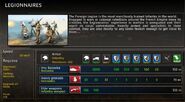Advanced infantry are the backbone of armies and the war-winning units that capitalize enemy bases. In France's case, it is true, as the Legionnaires are armed with the most elite infantry weapons. Accompanied by the right ruses, a single unit can wreck havoc on fixed artillery and light tank patrols as well as other infantry.
The French Foreign Legion (Légion Étrangère) is a historic part of France's military history, throughout the 1800s, France was known to recruit troops of foreign ethnicity (and soldiers who were part of another army) into their military. They were trained more rigorously compared to the main army, and had strong "esprit de corps", the Polish Lancer regiment within the Imperial Guard would be one example. The French Foreign Legion is considered to be an Elite branch within the French Land Army.
History[]
The Foreign Legion was heavily involved in World War II, playing a large role in the Middle East and the North African campaign. The 6th Foreign Infantry Regiment was established by consolidating battalions stationed in Syria into a single battalion on October 15, 1939. Around the beginning of the war the primary training camp of the Legion was located at Saïda, however by October 1939, another training camp was established at Bacarès near the Spanish border. The facility at Bacarès was re-purposed as training facility from an internment camp for Spanish refugees from the Spanish Civil War. Foreign Legion Forces being trained at these locations were provided inadequate arms and equipment - mostly surplus World War I-era equipment - which demonstrates the degree of low regard which the Foreign Legion by French military authorities.
The 13th Foreign Legion Demi-Brigade was raised in February 1940 for the purpose of deploying to Finland. By February 1940, over 84,000 foreigners had volunteered to serve France which led to great organizational difficulties for the French Foreign Legion. During this time a large number of recruits in the Foreign Legion were Spanish Republicans and East European Jews, many of whom held their personal ideologies very close to their hearts causing difficulty in their assimilation into the Foreign Legion. Not only did political refugees from Spain and East Europe prove difficult to assimilate into the Legion, but so did many of the reservist, former Legionnaires who returned to the Legion when called up as they were no longer young men and had families to look after. Most of Foreign Legion remained in training until the Germans launched their offensive against France on May 10, 1940.
Strategy[]
This section is a stub, so be patient and expand it.
Pros & Cons[]
+Ontop of being available in 1939, they require no upgrade and do not replace light infantry, leaving the player with economical flexibility and a major saving.
+Extremely Powerful AT Weapon At the level of Rangers Of the United States Behind the Panzersherck of Sturmgrenadier.
+The bias nature of the game, leaves them as the best infantry to deal with anything.
-10 currency, although they require no upgrade and don't replace light infantry.
Weapons[]
| Weapon | ||||||||||
|---|---|---|---|---|---|---|---|---|---|---|
Hvy Bazooka |
2000 | 500 | 250 | 125 | 100 | 60 | 150m |
| Weapon | ||||||||||
|---|---|---|---|---|---|---|---|---|---|---|
Heavy grenade |
33 | 33 | 33 | 7 | 3 | 2 | 1 | 0 | 70m |
| Weapon | ||||||||||
|---|---|---|---|---|---|---|---|---|---|---|
Elite weapons |
100 | 100 | 150m |
Gallery[]
Trivia[]
- They are the only infantry unit produced by the barracks which costs $10, making them quite expensive. However they are also one of the only elite infantry units available in 1939, and the only elite infantry not trained from an airfield.
See also[]
| ||||||||||||||||||||||||||

